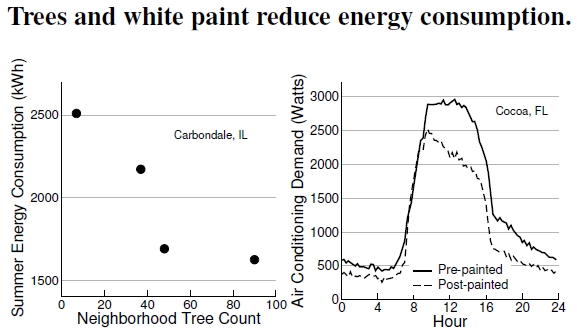3.14 Energy Reduction
Figure 3.14: At left, shade trees reduce summer energy consumption by about 25% for houses in Carbondale, Illinois (after Carver et al. 2004). This study compared one residential area with 7-8 trees per house on 0.25 hectare lots with another having 2-3 trees per house on 0.14 hectare lots. At right, white paint on the roof of a small strip mall in Cocoa, Florida, changed reflectivity from 28.8% to 75.3%, producing a 24% energy savings (after Parker et al. 1997).
What about energy? The results on energy reduction brought about by trees, in the left plot of Figure 3.14, come from a small study of 18 single-family homes across two sites in Carbondale, Illinois, during the summer season. One site had homes “ideally” surrounded by trees and plants, and the other had nonideally vegetated homes. I’ve plotted the data here as energy use against tree count: more trees, lower summer energy consumption. Across these sites, trees cool houses mostly by providing shade and reducing air temperatures through transpiration and reflecting sunlight.
Is the energy reduction cost-effective? From my electric bill, I calculate the savings between these two neighborhoods at about $100 per cooling season, or somewhere around $3 saved per tree per summer (about 20 kWh). I once called a tree service to take down part of a split tree leaning toward my house. That job cost a few hundred dollars, but I know of people paying $2,500 to have a very large tree removed, avoiding what might be very high repair costs.
With regard to balancing costs and benefits for a single tree, suppose a 50-year lifetime and a cooling value over that lifetime of, perhaps, $150. If it’s close to a house, the need to call a tree service to take it down erases the entire benefit and more.[64]
Alternatively, the simple act of painting roofs white also provides direct energy reductions, as shown in the right-hand plot.[65] Generally, increasing the albedo of house coatings yields energy savings of 20 to 80%.[66] It isn’t as beautiful as a tree, but painting a roof white costs very little in the right environment. A 1998 study showed that changing albedo and planting trees in the Los Angeles basin cost 0.4 cent for each kWh saved.[67] One of my 2007 electric bills shows a cost of around 15 cents per kWh. Even if the cost from 10 years ago escalated a factor of ten, the savings seem really good. But keep in mind that savings from painting the world white aren’t universal. Simulations of buildings in Toronto, Ontario, indicate unimpressive energy savings from cool roofs and trees, mostly because reflective roofs cost energy in the winter, a time when homeowners want low albedoes, letting sunshine warm up a house.[68]
Coming back to trees, we see here summer cooling energy reductions, and energy reductions mean lower fossil fuel consumption. A Los Angeles study claims that the average tree prevents 18 kg of emissions each year from power plants while sequestering 4.5 to 11 kg directly. The average tree reduces emissions in several other cities by 10 to 11 kg/year.[69] These numbers agree with the conversion between wood and electrical energy discussed in Figure 3.16.
In summary, well-planned energy-reduction strategies produce savings in the following proportions: 20% from cool roofs, 30% from shade from trees, and 37% windbreak from trees. Remaining savings come from citywide temperature reductions through broadly adopted house-scale strategies.[70]
————————–
[64]I counted 43 tree service entries in the Durham/Chapel Hill phone book. Suppose that each one takes down 200 trees per year, and we’re at about 10,000 trees removed in an area with, say, 100,000 houses, or one tree taken down every decade for each house. That’s a believable number that agrees with my personal experience (but I have my own chainsaw for the easy situations). If tree removal costs run about $500, that roughly equals the savings on the electric bill over a decade. Motivating trees through summer energy savings doesn’t seem very compelling, again due to the tree maintenance issue.
[65]Interestingly, examination of the air conditioning systems in the strip mall that Parker et al. (1997) studied uncovered numerous problems that also led to excess energy use, though repairs were undertaken before the experiment began.
[66]House energy savings through albedo changes are discussed in Akbari et al. (2001), and Parker et al. (2003) have house roof comparisons. For example, nine Florida homes with newly applied high albedo roof coatings, discussed by Akbari et al. (2001), citing Parker (1995), reduced average air conditioning costs by 19%.
[67]Electrical use changes with albedo changes and tree planting in Los Angeles are discussed by Hall (1998).
[68]Cold-climate roof-coating energy issues are discussed in Akbari and Konopacki (2004).
[69]Akbari (2002) discusses indirect sequestration by trees through their energy reduction in Los Angeles and other cities.
[70]General energy reduction strategies are discussed in Akbari and Konopacki (2004).

In footnote [64] I write: “If tree removal costs run about $500, that roughly equals the savings on the electric bill over a decade.” Thinking about it now, I’m not sure how I came up with that equality (I wrote it a few years ago). However, if you have a dozen trees around your house, each providing, say, a few dollars in energy savings per year, then the total benefit might sum to $50 per year, equaling $500 over a decade. On a “per tree” basis though, the equality mentioned above can’t hold.